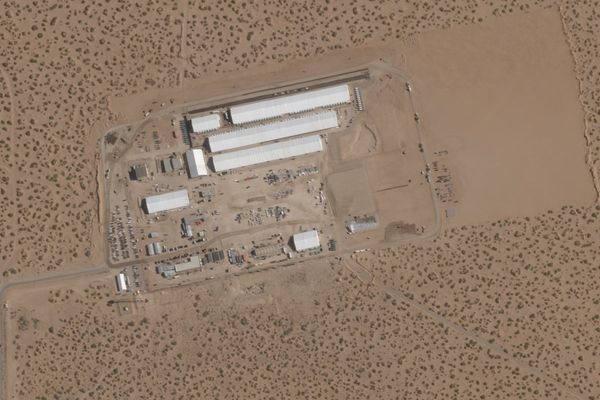
G7 experts are set to arrive in India on a fact-finding mission this week ahead of the expected announcement of a new embargo on importing Russian diamonds. An EU ban has also been under discussion for months – but imposing new regulations on the global diamond market is no easy feat.
Experts from the G7 and Belgium will discuss potential sanctions on Russian-mined diamonds this week on a visit to the Indian cities of Mumbai and Surat.
The trip is the latest step forward in months of negotiations among Western powers over how to impose sanctions that could transform a sprawling – and often controversial – global industry.
Around one-third of the world’s supply of diamonds are mined in the Siberian region of Yakutia by Russian state-owned company Alrosa. The diamond industry overall contributes around $4.5 billion to the Russian economy annually, making it one of the largest sectors in Russia to avoid the sweeping sanctions imposed by Western powers since the start of the full-scale invasion of Ukraine in 2022.
But this is not for lack of trying. Individual countries such as the US and UK have introduced their own sanctions on the luxury stones even while discussions over diamond sanctions among the EU stalled due to pushback from member state Belgium.
Belgium’s port city of Antwerp is home to the centuries-old Diamond District – the world’s largest diamond trading hub.
Approximately 84% of the world’s rough-cut diamonds and 50% of all polished diamonds are traded through the Belgian city, equivalent to around $220 million dollars' worth of diamonds every day.
Belgium has argued EU sanctions would excessively penalise its economy while leaving other EU economies relatively intact and Russia free to sell its diamonds outside the bloc.
Tracing the stones
If the typical diamond mined in Russia is then traded in Belgium, the next stop on its journey to the jewellery shop window is almost certainly in Surat on India’s west coast, where 80% of the world’s diamonds are cut and polished.
Here the diamond trade employs around 1.5 million people and is worth around $30 billion in both imports and exports.

Once polished, the majority of gems are likely to end up in either New York – gateway to the world’s largest market for polished diamonds, the United States – or Hong Kong to be channelled into the Chinese market.
However, diamonds can bounce between multiple other destinations. Botswana and Canada are also major producers while Israel, Dubai and India are significant trading hubs. There is also a growing cutting and polishing industry in the Chinese cities of Guangzhou and Shenzhen.
In short, from mine to retail, any diamond “will change hands usually a number of times”, says Edahn Golan, a diamond industry analyst based in Tel Aviv.
Herein lies a fundamental problem with imposing sanctions: traceability.
Most diamonds are initially exported as rough gems that have not yet been cut or polished. At first, they can be fairly easily tracked.
“International trade of rough is somewhat regulated,” says Golan. “Every time you want to export a rough diamond from one country and import into another, there's paperwork involved that denotes where the diamond was mined, the origin, the shipper, the company that's selling the diamond and the recipient.”
Complications arise when diamonds are traded multiple times between different locations.
If traders in Antwerp or Tel Aviv prepare parcels of diamonds to send to a manufacturer, they can mix similar stones from (for example) Russia, Botswana or Canada. The whole package is then labelled as being of “mixed” origin from that point onward.
When a parcel of mixed diamonds arrives, specialist scientists or experienced traders may be able to identify the geographical origin of individual gems – but this is not done on an industrial scale. In this way, large numbers of Russian stones could easily fly under the radar.
“That is one of the primary ways of avoiding the sanctions,” says Golan. “Traders can add one stone that came from anywhere else in the world, close up the parcel, ship it as 'mixed' origin, and it's perfectly legal.”

Tracing a diamond's origin is even more complicated for exports of polished gems.
Even as a car made up of parts manufactured around the world will be labelled as Japanese if it is assembled in a factory in Japan, a similar principle holds for diamonds. A stone that comes from anywhere in the world can be classed as "Indian" if it has been polished and cut in India.
This is an issue that current US sanctions on imports of rough Russian diamonds does not address. “Right now, the US has what I would call 'softer' sanctions on the importation of Russian diamonds,” says Paul Zimnisky, a diamond industry analyst based in New York.
“Russian-origin diamonds can still be imported as long as they were transformed or cut and polished outside of Russia.”
New technologies
New sanctions from the G7 aim to go further than existing US sanctions to “block all Russian-origin diamonds from Western consumer markets”, says Zimnisky.
To do this, the G7 has said it will implement a new traceability system, which could see Antwerp function as a central sorting hub where Russian stones are eliminated and others are allowed to enter G7 markets.
The technical aspects of the sorting system have not yet been revealed, although experts have their theories.
“I think sanction enforcement will be some combination of document-based auditing via customs but will also incorporate the new tracking technology on the market, which uses high-resolution imaging to 'fingerprint' a stone and then register it on a blockchain-like system,” says Zimnisky.
Golan says the SWIFT banking system could be used to track payments, along with non-invasive laser technology that marks each individual stone with a unique identification.
However, Golan foresees issues with either system. First, industry actors across the entire global trade, manufacture and retail pipeline will need to implement the same technologies simultaneously.
Second, he says, “even the best technologies don’t work for every diamond. And below a certain size, economically, tracing even doesn't make any sense. There are some diamonds that trade for $4 or $5 [or] $6 per carat – nobody wants to trace them”.
Smaller diamonds are even more likely to fly under the radar, Golan adds, as a laser-marked diamond that is then divided into smaller stones will not retain the unique identity mark on every piece, making it impossible to use the system to validate the diamonds' origin.
New markets?
Belgium, initially resistant to sanctions packages, has been brought round by the promise of expanding the measures to cover all G7 countries, rather than just the EU, and by the promise of a central role for Antwerp’s diamond industry.
During a September visit to New York where he met diamond industry leaders, Belgian Prime Minister Alexander De Croo said that new traceability measures should be introduced in time for sanctions on Russian diamonds to be imposed by January 2024.
There are also promising signs of cooperation from India, whose leadership has striven to maintain diplomatic ties with both Russia and the West since the full-scale invasion of Ukraine.
Russian diamond producer Alrosa has suspended rough diamond supplies for September and October at New Delhi’s request, India's Gem and Jewellery Export Promotion Council said on Wednesday.
The move was put down to an attempt to counter oversupply in the global market and stabilise diamond prices amid weak demand. But, Golan says, the pause in Russian diamonds entering India lines up neatly with potential sanctions from the West.
If sanctions are imposed, as expected, Zimnisky believes the international diamond trade will simply adapt. “We might see certain categories of non-Russian diamonds trade at a premium from time to time. I don’t expect a material price impact in the near term at least, as the trade has had ample time to prepare for this.”
Golan predicts an inevitable boost within G7 markets for diamonds from countries such as Botswana and Canada.
Outside the G7 market, sales of Russian diamonds may well expand into countries still maintaining diplomatic ties with Russia.
India’s internal retail market for diamonds grew steadily in 2022 and there are positive signs of demand recovering in China, according to an annual report from international diamond company De Beers.
“My guess is that we will find a lot more traders trying to sell in China,” Golan says. “China is still a depressed market, but just last month we saw a little increase in [diamond] jewellery sales since Covid."







